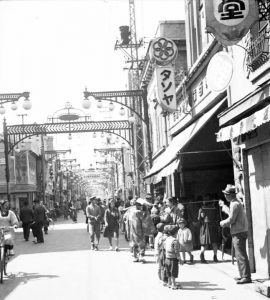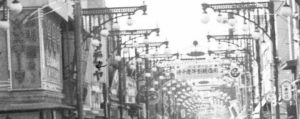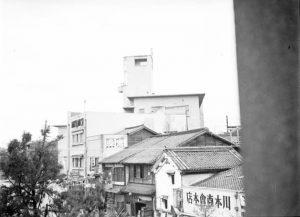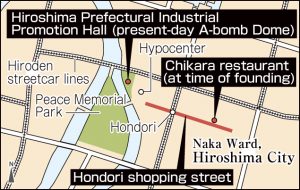Striving to fill voids in Hiroshima—Recreating cityscapes: Energy fills photos with visible shop names, including “Chikara” restaurant at time of founding
Jan. 4, 2023
Photos anticipated to be utilized for upcoming summit
by Kyosuke Mizukawa, Senior Staff Writer
The Hiroshima Peace Memorial Museum, located in the city’s centrally located Naka Ward, received a donation of 26 black-and-white photographs taken in Hiroshima City sometime between 1941 and 1942 with their photographic negatives. The images vividly reveal the appearances of the Hiroshima Prefectural Industrial Promotion Hall (present-day A-bomb Dome, in the city’s Naka Ward) and the Hondori shopping street (part of Naka Ward). Hiroshima will play host to the summit meeting of the G7 (attended by the Group of Seven industrialized nations) in May, which means the images will serve as valuable materials for conveying the image from long ago of Hiroshima, which was annihilated instantly in the atomic bombing.
One of the photos depicts the central part of the Hondori shopping street, known as one of the most bustling streets in the city even before the war, looking from east to west. Enlarging the photo makes legible words on shop signboards, too small to discern in the original photos, such as the sponge cake retailer “Kinmeido Castella” and “Yamamoto Shoes.” In the background of the photo is hung a banner that declares “Closing time, 10 p.m.,” implying that the street was filled with people coming and going even at night.
According to the museum, the shop directly to the west of the Tasoya Department Store with its “Tasoya” sign was the “Chikara” restaurant, founded on that spot in 1935 and currently managed as an udon noodle restaurant in the city’s Naka Ward. A Chikara representative indicated that the photo of the company’s former restaurant doing business before the war had not been archived internally at the company, making it a truly precious image. Just before the atomic bombing, the Hondori shopping street is said to have contained about 160 shops, all of which burned to the ground when the U.S. military dropped the atomic bomb on August 6, 1945.
The photographs were taken by Hideo Kokawa, who died in 2014 at the age of 93. Hideharu Kokawa, 73, Hideo’s oldest son who is a resident of Hiroshima’s Asakita Ward, said, “My father loved taking photos and carefully held on to the negatives. I’m pleased that his photos and negatives are proving useful now.” Mr. Kokawa was born to a family of Japanese immigrants who had moved from the same Asakita Ward in Hiroshima to the United States. He once returned to Japan, attended school in Hiroshima, and then went back to the United States. While engaged in housekeeping work at home of an actor in Los Angeles, he went to a local school there. In the United States, he purchased the camera he used for taking the photos that were donated to the museum.
After he came back to Japan in March 1941, he got a job at the Japan Trade Promotion Association’s Hiroshima branch office, located in the Industrial Promotion Hall. Later, at the time of the atomic bombing, he was outside of Hiroshima Prefecture serving in the military. After the bombing, however, he entered the city in search of his younger sister, who had been working in the downtown part of Hiroshima. She had died, it turned out, in the atomic bombing.
Mr. Kokawa shared his A-bombing experience in a videotaped testimonial, recorded in 1998, that has been released to the public by the Hiroshima National Peace Memorial Hall for the Atomic Bomb Victims, located in the city’s Naka Ward. “If I had been there at that time (Industrial Promotion Hall), I would have died,” he explained in the video. According to the museum, his association’s branch office had been relocated to another site by the spring of 1944, but the hall still housed some offices, including a company related to the management of rationing of lumber and other wood materials, at the time of the atomic bombing. The Record of the Hiroshima A-bomb War Disaster (published in 1971) indicated that about 30 people who had been in the hall died in the bombing. However, the whole picture of all the damage done to the hall is still unclear.
Before the museum collected Mr. Kokawa’s photos, Kumiko Murakoshi, 64, a resident of Higashi Ward, provided help, based on the fact that her deceased mother was a colleague of Mr. Kokawa at the branch office. As Ms. Murakoshi served as one of the A-bomb Legacy Successors, a position appointed by the Hiroshima City government for passing on the experiences of the A-bomb survivors, she helped connect a curator at the museum who was looking for the material with Hideharu Kokawa. “I hope that the photos give people a sense that the damage caused by the atomic bombing was not someone else’s problem,” said Ms. Murakoshi. She anticipates that Mr. Kokawa’s photos will be fully utilized.
(Originally published on January 4, 2023)











